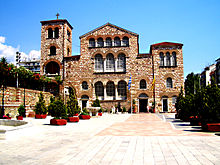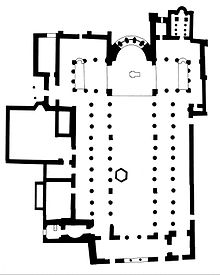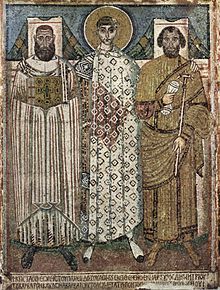Hagios Demetrios
The church of Hagios Demetrios ( Greek Άγιος Δημήτριος Agios Dimitrios ) or simply Demetriosbasilika is a church dedicated to St. Early Byzantine Church in Thessaloniki consecrated to Demetrios of Thessaloniki . It is located at the foot of the hill of the upper town near the old market and is dedicated to this early Christian saint, one of the most important saints of the Greek Orthodox Church . Since 1988 the church has been part of the UNESCO World Heritage of Early Christian and Byzantine Buildings in Thessaloniki .
history
According to some scholars, the first small church was built in the early 4th century on the site of a Roman bath complex. A century later, a three-aisled basilica followed, which was repeatedly damaged by fire and earthquakes.
In the years 629 to 634 it was rebuilt as a five-aisled basilica.
In the Ottoman period, from 1493 to 1912, the church was used as a mosque and was named Kasımiye Camii in Turkish .
The great city fire of 1917 led to the destruction of the roofs and the upper wall sections. The reconstruction, taking into account the remaining substance, during which extensive excavations took place, dragged on until 1949.
construction
basilica
The church is a five-aisle, flat-roofed basilica with an open roof of 53.58 meters long and 33 meters wide with galleries and clerestory above the aisles, and two rows of arcades with alternation of supports , three-aisled cross house and narrow narthex and dreibogigem input (Trivelum). The column capitals of great variety are mostly Spolia.
crypt
The crypt, once a place of worship for Demetrios, who according to tradition was killed here, is built in the Roman thermal baths. In Islamic times it was filled up. It is accessible from the southern arm of the transept and is now used as a museum on the history of the church.
Euthymios Chapel
The three-aisled chapel of St. Euthymios on the east side of the south transept was donated in 1302/3 by Michael Glabas Tarchaniotis and his wife Maria Palaiologina. Her frescoes, which are related to the Protaton on Mount Athos and the Períblebtos Church in Ochrid , represent the painting of the palaeologists' time in Thessaloniki.
Furnishing
Mosaics
Large parts of the furnishings, including the painting and the mosaics , were lost in the fire in 1917. Only sparse remains of the marble incrustations have survived . Nine of the once rich furnishings with mosaics from the 5th to 9th centuries have been preserved on the crossing pillars and on the west wall of the nave, which were uncovered in 1917. These pictures, created by a Byzantine mosaic workshop in Thessaloniki, are counted among the most important examples of early Byzantine mosaic art .
Renaissance tomb
The marble tomb of Loukás Spantoúnis dates from 1481 and is stylistically assigned to the Venetian Renaissance , a period in which Thessaloniki was partly under the influence of Venice . Nevertheless, it is unusual to find such a Renaissance tomb in a church in Greece.
literature
- Andreas Xyngopoulos: Η βασιλική του Αγίου Δημητρίου Θεσσαλονίκης. Thessaloniki 1946.
- Georgios Sotiriou: Η βασιλική του Αγίου Δημητρίου Θεσσαλονίκης. Athens 1952.
- Robin S. Cormack: The mosaic decoration of S. Demetrios, Thessaloniki. In: Annual of the British School at Athens 64 (1969) pp. 16-52.
- Andreas Xyngopoulos: Τα ψυφιδωτά του ναού του Αγίου Δημητρίου Θεσσαλονίκης. Thessaloniki 1969.
- Charalambos Bouras: Το επιτύμβιο του Λουκά Σπαντούνη στη βασιλική του Αγίου Δημητρίου Θεσσαλονίκης. Epistimonikí Epetirís tis Polytechnikís Scholís tou Aristoteleíou Panepistimíou Thessaloníkis, St-I, 1973, pp. 1-63.
- Thalia Gouma-Peterson: The Parecclesion of St. Euthymios in Thessalonica. Art and monastic policy under Andronicos II. In: Art Bulletin 58 (1976) pp. 168-183.
- Demetrios Pallas: Le ciborium hexagonal de Saint-Démétrios de Thessalonique. In: Zograf 10 (1979) pp. 44-58.
- Charalambos Bakirtzis: Η βασιλική του Αγίου Δημητρίου. Thessaloniki 1986.
- Thalia Gouma-Peterson: The frescoes of the Parecclesion of St. Euthymios in Thessaloniki - Patrons, Workshops and Style. In: Twilight of Byzantium. Papers from the Colloquium held at Princeton University, 1989, pp. 111-129.
- Eutychia Kourkoutidou-Nikolaïdou, Anastasia Tourta: Walks through Byzantine Thessaloniki. Editions Kapon, Athens 1997, ISBN 960-7254-48-1 , pp. 153-175.
- Benjamin Fourlas: Κτίστας θεωρεῖς. Who is the civil dignitary on the donor mosaic in the Demetrios Church in Thessaloniki? In: Byzantina Symmeikta 20, 2010, pp. 195–244 full text .
- Franz Alto Bauer : A city and its patron. Thessaloniki and Saint Demetrios . Schnell and Steiner, Regensburg 2013, ISBN 978-3-7954-2760-3 .
Web links
- Entry on the UNESCO World Heritage Center website ( English and French ).
- Greek Ministry of Culture
Individual evidence
- ↑ UNESCO World Heritage List - Paleochristian and Byzantine Monuments of Thessalonika (English)
- ↑ Eutychia Kourkoutidou-Nikolaidou, Anastasia Tourta: walks through the Byzantine Thessaloniki. Editions Kapon, Athens 1997, ISBN 960-7254-48-1 , p. 154
- ↑ Apostolos Papajannopoulos: monuments of Thessaloniki. Rekos, Thessaloniki 1983, p. 44.
- ↑ Dana Facaros, Linda Theodorou: Greece (Cadogan Guide Greece). London 2003, p.
Coordinates: 40 ° 38 ′ 20 ″ N , 22 ° 56 ′ 53 ″ E





